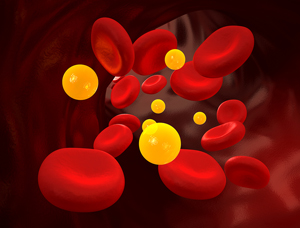For some 30 years now, I’ve been saying that the cholesterol theory–the medical canard that cholesterol is the major cause behind heart disease is little more than a myth. Against my views and the views of a number of others in the alternative health communty, however, stood the fact that almost 1/3 of all American adults over the age of 45 are now prescribed statin drugs to lower their cholesterol–at a cost of over $14 billion a year.1 “Evaluating statin drugs to treat: High Cholesterol and Heart Disease.” Consumer Reports. (Accessed 14 Mar 2015.) http://consumerhealthchoices.org/wp-content/uploads/2012/08/BBD-Statins-Full.pdf In fact, prescriptions for statin drugs have been steadily rising over the years. Consumers Union reported that in the US alone the number of prescriptions for statins increased by an average of 500,000 a month between October 2005 and December 2006. Even worse, the goal for maximum LDL levels for patients at risk for heart disease was lowered from 100 to 70. And for patients with high risk for heart disease, trigger levels for LDL were dropped from 130 to 100. In 2010, AstraZeneca received permission from the FDA to sell Crestor to a potential new market of 6.5 million people, none of whom actually have cholesterol or heart problems. (You read that correctly — no problems, no symptoms!) That’s because the company got the FDA to agree that it could sell its statin drug as a preventative measure. The net result is that in the decade between 2003 to 2012, the percentage of people across the United States taking drugs to bring down LDL or “bad” cholesterol rose by nearly one-third.2 Qiuping Gu, Ryne Paulose-Ram. “Prescription Cholesterol-lowering Medication Use in Adults Aged 40 and Over: United States, 2003–2012.” NCHS Data Brief No. 177 December 2014. http://www.cdc.gov/nchs/data/databriefs/db177.pdf
To the casual observer over the past few years, it certainly would appear that cholesterol causes heart disease. But little by little, and unbeknownst to most people, this multi-billion dollar creation of the pharmaceutical/medical industry has been slain. It is officially dead. Unfortunately, like a zombie, that hasn’t stopped it from still walking around and killing the living–something that it will probably continue to do for a number of years yet. Let me explain.
The First Nail in the Cholesterol Theory Coffin
 In truth, the cholesterol theory and statin drugs were pretty much dead when it was announced in 2008 that a study sponsored by Merck and Schering-Plough found that after several years on two types of cholesterol-lowering medications, patients reduced their cholesterol level, but they reaped no significant health benefit at all unless they already had heart disease. Not surprisingly, Merck tried to spin these results in their ads claiming, “Lipitor reduces the risk of heart attack by 36%…in patients with multiple risk factors for heart disease.” An asterisk at the bottom included tiny print that noted that “….in a large clinical study, 3% of patients taking a sugar pill or placebo had a heart attack compared to 2% of patients taking Lipitor.” So although Merck was technically correct, a more accurate way of interpreting their results would be to say that for every 100 people who don’t take Lipitor, three will have heart attacks; whereas, for every 100 people who do take Lipitor, two will have heart attacks. In other words, Lipitor prevents only one heart attack per 100 users–but it made no difference in their final outcome.
In truth, the cholesterol theory and statin drugs were pretty much dead when it was announced in 2008 that a study sponsored by Merck and Schering-Plough found that after several years on two types of cholesterol-lowering medications, patients reduced their cholesterol level, but they reaped no significant health benefit at all unless they already had heart disease. Not surprisingly, Merck tried to spin these results in their ads claiming, “Lipitor reduces the risk of heart attack by 36%…in patients with multiple risk factors for heart disease.” An asterisk at the bottom included tiny print that noted that “….in a large clinical study, 3% of patients taking a sugar pill or placebo had a heart attack compared to 2% of patients taking Lipitor.” So although Merck was technically correct, a more accurate way of interpreting their results would be to say that for every 100 people who don’t take Lipitor, three will have heart attacks; whereas, for every 100 people who do take Lipitor, two will have heart attacks. In other words, Lipitor prevents only one heart attack per 100 users–but it made no difference in their final outcome.
The scariest part is that those tainted figures, as pathetic as they are, were rosier than reality, given that they come from an industry-sponsored study with a vested interest in proving that their product worked. In fact, a parallel study sponsored by the government found taking statins results in no statistically significant health benefit whatsoever in those without preexisting heart disease. If you think about it, that pretty much kills the cholesterol theory of heart disease and minimizes the value of statin drugs. Nevertheless, as I’ve already mentioned, despite the lack of scientific support, the guidelines for prescribing statins to “moderate” this non-existent condition keep getting lower and lower, with numbers tripling since 2001. Again, like a zombie, even though it is dead, thanks to the efforts of the pharmaceutical/medical community, it still manages to stagger about terrorizing the citizenry.
The Second Nail in the Cholesterol Theory Coffin
 By 2014, the medical community had at least become aware enough of the issue to debate it. The April 14th issue of the Journal of the American Medical Association inaugurated a new feature called “Viewpoint”–an “in magazine” debating forum for arguing out key medical issues of the day. Think of it like a civilized version of Dan Aykroyd and Jane Curtain’s Point/Counterpoint sketches on Saturday Night Live.3 http://www.hulu.com/watch/2306 The subject of the first debate was statin drugs–or more precisely: “Should a 55-year-old man who is otherwise well, with systolic blood pressure of 110 mm Hg, total cholesterol of 250 mg/dL and no family history of premature CHD [coronary heart disease] be treated with a statin?”
By 2014, the medical community had at least become aware enough of the issue to debate it. The April 14th issue of the Journal of the American Medical Association inaugurated a new feature called “Viewpoint”–an “in magazine” debating forum for arguing out key medical issues of the day. Think of it like a civilized version of Dan Aykroyd and Jane Curtain’s Point/Counterpoint sketches on Saturday Night Live.3 http://www.hulu.com/watch/2306 The subject of the first debate was statin drugs–or more precisely: “Should a 55-year-old man who is otherwise well, with systolic blood pressure of 110 mm Hg, total cholesterol of 250 mg/dL and no family history of premature CHD [coronary heart disease] be treated with a statin?”
The pro position relied on the usual arguments. More interesting, though, was the con position as expressed by the editorial staff of the Archives of Internal Medicine. As they pointed out, “Data from a meta-analysis of 11 trials including 65,229 persons with 244,000 person-years of follow-up in healthy (normal cholesterol levels) but high-risk men and women showed no reduction in mortality when treated with statins4 Ray KK, Seshasai SR, Erqou S, et al. “Statins and all-cause mortality in high-risk primary prevention: a meta-analysis of 11 randomized controlled trials involving 65,229 participants.” Arch Intern Med. 2010;170(12):1024–1031. http://archinte.ama-assn.org/cgi/reprint/170/12/1024.pdf?ijkey=0490a19d9a2a092d57029b423deab38112bef2cd (a fact I have repeatedly pointed out over the years.) In addition, a 2011 Cochrane Review of treatment with statins among persons without documented coronary disease came to similar conclusions.5 Taylor F, Ward K, Moore TH, et al. “Statins for the primary prevention of cardiovascular disease.” Cochrane Database SystRev. 2011;(1):CD004816. http://www.ncbi.nlm.nih.gov/pubmed/21249663 The Cochrane Review also observed that all but one of the clinical trials providing evidence on this issue were sponsored by the pharmaceutical industry. It is well established, as surprising as it might be to some in the medical community, that industry-sponsored trials are more likely than non-industry-sponsored trials to report favorable results for drug treatment because of biased reporting, biased interpretation, or both.6 Lexchin J, Bero LA, Djulbegovic B, Clark O. “Pharmaceutical industry sponsorship and research outcome and quality: systematic review.” BMJ. 2003;326(7400):1167–1170. http://www.bmj.com/content/326/7400/1167.abstract?ijkey=9130651a991766c57c1a168de2819b23fe677709&keytype2=tf_ipsecsha
Needless to say, despite the overwhelming evidence presented by the team from the Archives of Internal Medicine, the debate changed little. Like the zombies in World War Z,7 http://www.youtube.com/watch?v=HcwTxRuq-uk statin drug prescriptions continued to surge forward, chasing down the living and their life force as represented by their medical insurance dollars.
The Third Nail in the Cholesterol Theory Coffin
To understand the third nail, we need to take a quick journey through the history of the cholesterol theory of heart disease. Cholesterol was first isolated from gallstones in 1784, with its exact molecular formula being established a century later in 1888 by Austrian botanist Friedrich Reinitzer. However, it wasn’t until the early 1900’s that the apparent link between cholesterol and heart disease was identified. In 1910, German chemist Adolph Windaus observed that atherosclerosis plaque from human aortas contains cholesterol in 20 to 26 times the concentrations of cholesterol found in normal aortas.8 Akira ENDO. “A historical perspective on the discovery of statins.” Proc Jpn Acad Ser B Phys Biol Sci. 2010 May 11; 86(5): 484–493. http://www.ncbi.nlm.nih.gov/pmc/articles/PMC3108295/ It wasn’t cause and effect, but it was an intriguing relationship to say the least.
 In 1913, the theory was put to the test when Nikolai Anichkov and his team of researchers at the Czar’s Military Medicine Institute in St. Petersburg determined that feeding high cholesterol diets to rabbits resulted in damage to their cardiovascular systems.9 Igor E. Konstantinov, Nicolai Mejevoi, Nikolai M. Anichkov. “Nikolai N. Anichkov and His Theory of Atherosclerosis.” Tex Heart Inst J. 2006; 33(4): 417–423. http://www.ncbi.nlm.nih.gov/pmc/articles/PMC1764970/ A connection had been made, but it had little impact on treatment. It wasn’t until half a century later, in 1961, that the American Heart Association established dietary guidelines for cholesterol, giving warnings about the dangers of eating foods high in cholesterol and saturated fats such as eggs, shrimp, butter, and red meat.10 Steinberg D, Gotto AM Jr. “Preventing coronary artery disease by lowering cholesterol levels: fifty years from bench to bedside.” JAMA 1999;282:2043–50. http://www.ncbi.nlm.nih.gov/pubmed/10591387 Not long after, the federal government adopted those same guidelines and it was off to the races. Suddenly, a plethora of “new” foods devoid of saturated fats and cholesterol but packed with partially hydrogenated oils and synthetic trans fatty acids hit the market. (And how did that turn out?) Not to be left behind, the pharmaceutical industry madly rushed to discover any possible, patentable, money-making-solutions. In fact, during the 1950s and 1960s, many cholesterol-lowering agents were reported and introduced into clinical use, including nicotinic acid, cholestyramine, clofibrate, neomycin, plant sterols, triparanol, D-thyroxine, and estrogenic hormones–all with minimal to, at best, moderate success. Then, in 1971, after two and a half years spent examining 6,392 fungi, Dr. Akira Endo discovered Mevastatin–the world’s first statin drug. Even though Mevastatin was never marketed because of its adverse effects on tumors, muscle deterioration, and sometimes death in laboratory dogs, it marked the beginning of the statin revolution, which hit full stride beginning in the early 90’s with the introduction of Mevacor, Pravachol, and Lipitor.
In 1913, the theory was put to the test when Nikolai Anichkov and his team of researchers at the Czar’s Military Medicine Institute in St. Petersburg determined that feeding high cholesterol diets to rabbits resulted in damage to their cardiovascular systems.9 Igor E. Konstantinov, Nicolai Mejevoi, Nikolai M. Anichkov. “Nikolai N. Anichkov and His Theory of Atherosclerosis.” Tex Heart Inst J. 2006; 33(4): 417–423. http://www.ncbi.nlm.nih.gov/pmc/articles/PMC1764970/ A connection had been made, but it had little impact on treatment. It wasn’t until half a century later, in 1961, that the American Heart Association established dietary guidelines for cholesterol, giving warnings about the dangers of eating foods high in cholesterol and saturated fats such as eggs, shrimp, butter, and red meat.10 Steinberg D, Gotto AM Jr. “Preventing coronary artery disease by lowering cholesterol levels: fifty years from bench to bedside.” JAMA 1999;282:2043–50. http://www.ncbi.nlm.nih.gov/pubmed/10591387 Not long after, the federal government adopted those same guidelines and it was off to the races. Suddenly, a plethora of “new” foods devoid of saturated fats and cholesterol but packed with partially hydrogenated oils and synthetic trans fatty acids hit the market. (And how did that turn out?) Not to be left behind, the pharmaceutical industry madly rushed to discover any possible, patentable, money-making-solutions. In fact, during the 1950s and 1960s, many cholesterol-lowering agents were reported and introduced into clinical use, including nicotinic acid, cholestyramine, clofibrate, neomycin, plant sterols, triparanol, D-thyroxine, and estrogenic hormones–all with minimal to, at best, moderate success. Then, in 1971, after two and a half years spent examining 6,392 fungi, Dr. Akira Endo discovered Mevastatin–the world’s first statin drug. Even though Mevastatin was never marketed because of its adverse effects on tumors, muscle deterioration, and sometimes death in laboratory dogs, it marked the beginning of the statin revolution, which hit full stride beginning in the early 90’s with the introduction of Mevacor, Pravachol, and Lipitor.
But last month, in what can only be considered a stunning reversal, the U.S. Dietary Guidelines Advisory Committee recommended that cholesterol should no longer be listed as a “nutrient of concern.”11 “Scientific Report of the 2015 Dietary Guidelines Advisory Committee.” health.gov. (Accessed 14 Mar 2015.) http://www.health.gov/dietaryguidelines/2015-scientific-report/
According to the Committee, this turnaround is in keeping with mounting evidence that for most healthy adults, eating foods high in cholesterol does not significantly contribute to the amount of cholesterol found in the blood–most of which is produced naturally by the body. And while the Committee continues to warn that individuals with health problems such as diabetes or heart disease should continue to avoid high-cholesterol foods, they unequivocally state that such foods’ overall impact on good health seems to be less significant than was previously thought. “It’s turned out to be more complicated than anyone could have known,” says Wake Forest University biochemist Lawrence Rudel. In fact, in one example of this complexity, the Russian research paper mentioned above that launched the cholesterol revolution noted that while the cholesterol diet harmed rabbits, it had no effect on white rats. As it turns out rabbits are unusually vulnerable to the high-cholesterol diet. Rats and humans not so much. In other words, much of what we have assumed about cholesterol for the last century is based on a “rabbitical” fallacy.
And the results have been disastrous.
Other than the studies conducted by Dr. Dean Ornish, there has never been any evidence that eating less fat and cholesterol helps reduce the risk of heart disease. Nevertheless, people did as they were told and en masse shifted their diets away from meat, dairy, and fat–replacing them with simple carbohydrates such as sugar, white bread, pasta, and processed foods. The disaster turned out to be that these are the real drivers of obesity, diabetes, and heart disease. The obesity epidemic began with the American Heart Association’s establishment of dietary guidelines for cholesterol and fat. Thank you very much!
In any case, the U.S. Dietary Guidelines Advisory Committee has decided to no longer classify cholesterol as a “nutrient of concern.” This reverses a half century of government advice and reflects recent research that demonstrates that eating foods high in cholesterol does not significantly raise cholesterol levels in the blood or increase the risk of heart disease. According to the new guidelines, genetics have a much greater effect on cholesterol levels than diet, although blaming it on genetics is also a misrepresentation of reality. Genetics only accounts for a small number of cases of elevated cholesterol. (To learn more about how cholesterol levels are regulated in your body and what drives those numbers up, check out: /article/understanding-liver-and-cholesterol. And to learn more about why cholesterol isn’t really the boogieman it’s been made out to be, check out: /article/cholesterol-myth)
It should be noted that the new guidelines, despite backing down from cholesterol and recommending a diet higher in plant-based foods, such as vegetables, fruits, whole grains, legumes, nuts and seeds, have nevertheless doubled down on two shibboleths.
- Although the guidelines recommend cutting back on sugars and refined grains, they make clear that the major danger is too many servings of foods heavy with saturated fats, such as fatty meats, whole milk, and butter. But this, as we have explored previously, is wildly dependent on how those foods are raised. There is a vast difference in the type of fats found in meat, dairy, and butter as found in grain fed cattle VS grass fed cattle–and thus a vast difference in health outcomes. Grass fed animal products have a omega-6 to omega-3 ratio approaching 1:1. Grain fed animals produce fat that can easily reach levels of 20:1 to 30:1. This dramatically increases the risk of heart attacks.
- And the new view on cholesterol in food does not reverse warnings about high levels of “bad” cholesterol in the blood, thus encouraging the continued overuse of statin drugs, despite the mounting evidence that they don’t work and carry the risk of severe side effects.
Incidentally, the new guidelines touched on a brand new area of consideration in diet: sustainability. As they indicate, food sources that are resource light such as plant-based foods are preferable to foods that are resource intensive such as meat-based products. Quite simply, as populations grow, the sustainability of diet is a crucial consideration. They are absolutely correct; sustainability of our food supply is a vital issue! And for that reason alone, let us hope that the paleo diet doesn’t turn out to be as healthy as its advocates claim. If it does, we’re all screwed as it’s simply unsustainable if enough people adopt it.
By the way, if you’re interested in reading the guidelines: Click here.
The Fourth Nail in the Cholesterol Theory Coffin
Those of you who are old enough may remember that for years there was no distinction between good cholesterol and bad cholesterol. All you were told is that you had to eat fake margarine to keep your cholesterol levels down. It was only some time later that researchers discovered that HDL (the good cholesterol) was actually heart protective whereas it was only the LDL (or bad cholesterol) that needed to be reduced. From that point on, it was all about maintaining healthy cholesterol ratios between your HDL and LDL. The new guidelines haven’t changed that assessment; they’ve only changed what they say makes those LDL levels climb. But there focus on “LDL” is wrong. As it turns out, focusing on LDL cholesterol as the cause of heart problems is little better than focusing on simple overall cholesterol levels. As it turns out, things are more complex than HDL VS LDL.
LDL (Low-density lipoprotein) is one of the five major groups of lipoproteins. These groups, from largest to smallest (least dense to most dense when compared with the surrounding water), are: chylomicrons (ULDL), very low-density lipoprotein (VLDL), intermediate-density lipoprotein (IDL), LDL, and high-density lipoprotein (HDL). But, and here’s the surprise, LDL cholesterol itself is divided into four different major “groups” or forms, and all of the different forms within those groups are distinctly different from each other with entirely different effects on the body. Some are safe and some are dangerous, and treating them all as one thing (as when we get an LDL: 130 reading from our doctor) provides virtually no useful information. Taking that number at face value can dramatically overestimate or underestimate the state of your health. And it may lead you to take dangerous levels of unnecessary medication or, conversely, to dangerously under-medicate. Since this is so crucial, let’s take a closer look.
 As I said, LDL comes in four basic groups as determined by their size and density: (1) large (the fluffiest), (2) medium, (3) small, and (4) very small (the densest). Studies have linked the smaller, dense LDL cholesterol particles to a higher risk of heart disease and stroke compared to the larger fluffy particles.12 Song TJ, Cho HJ, Chang Y, et al. “Low-density-lipoprotein particle size predicts a poor outcome in patients with atherothrombotic stroke.” J Clin Neurol. 2015 Jan;11(1):80-6. http://www.ncbi.nlm.nih.gov/pmc/articles/PMC4302183/ ,13 Karim Harchaoui, Wim van der Steeg, Erik Stroes, et al. “Value of Low-Density Lipoprotein Particle Number and Size as Predictors of Coronary Artery Disease in Apparently Healthy Men and Women : The EPIC-Norfolk Prospective Population Study.” Journal of the American College of Cardiology. Volume 49, Issue 5, 6 February 2007, Pages 547–553. http://www.sciencedirect.com/science/article/pii/S0735109706028634 This is true even if your overall LDL cholesterol is in the desirable range. Moreover, small, dense LDL tends to go along with related problems that increase cardiovascular disease risk — low HDL, high triglycerides, high blood sugar, high blood pressure and obesity. Small LDL particles are dangerous because they are better able to get into artery walls where dangerous plaque forms, thus promoting plaque build-up in your arteries). In addition, they are less easily cleared from the bloodstream. Now, here’s where it gets interesting. A diet high in saturated fat (the kind the new guidelines tell you NOT to eat) mainly boosts the numbers of large-LDL particles, whereas a low-fat diet, high in carbohydrates (the kind of diet the guidelines tells you that you should eat) boosts production of the smaller, dangerous forms of LDL. In case you didn’t understand the import of what you just read, what it means is that the big, fluffy LDL particles which come from eating saturated fats are largely benign, while the small, dense versions that come from eating carbohydrates lead to an early death. You read that right. The new guidelines, according to what we now know about LDL cholesterol, are going to continue to propagate heart disease–possibly at an accelerated rate.
As I said, LDL comes in four basic groups as determined by their size and density: (1) large (the fluffiest), (2) medium, (3) small, and (4) very small (the densest). Studies have linked the smaller, dense LDL cholesterol particles to a higher risk of heart disease and stroke compared to the larger fluffy particles.12 Song TJ, Cho HJ, Chang Y, et al. “Low-density-lipoprotein particle size predicts a poor outcome in patients with atherothrombotic stroke.” J Clin Neurol. 2015 Jan;11(1):80-6. http://www.ncbi.nlm.nih.gov/pmc/articles/PMC4302183/ ,13 Karim Harchaoui, Wim van der Steeg, Erik Stroes, et al. “Value of Low-Density Lipoprotein Particle Number and Size as Predictors of Coronary Artery Disease in Apparently Healthy Men and Women : The EPIC-Norfolk Prospective Population Study.” Journal of the American College of Cardiology. Volume 49, Issue 5, 6 February 2007, Pages 547–553. http://www.sciencedirect.com/science/article/pii/S0735109706028634 This is true even if your overall LDL cholesterol is in the desirable range. Moreover, small, dense LDL tends to go along with related problems that increase cardiovascular disease risk — low HDL, high triglycerides, high blood sugar, high blood pressure and obesity. Small LDL particles are dangerous because they are better able to get into artery walls where dangerous plaque forms, thus promoting plaque build-up in your arteries). In addition, they are less easily cleared from the bloodstream. Now, here’s where it gets interesting. A diet high in saturated fat (the kind the new guidelines tell you NOT to eat) mainly boosts the numbers of large-LDL particles, whereas a low-fat diet, high in carbohydrates (the kind of diet the guidelines tells you that you should eat) boosts production of the smaller, dangerous forms of LDL. In case you didn’t understand the import of what you just read, what it means is that the big, fluffy LDL particles which come from eating saturated fats are largely benign, while the small, dense versions that come from eating carbohydrates lead to an early death. You read that right. The new guidelines, according to what we now know about LDL cholesterol, are going to continue to propagate heart disease–possibly at an accelerated rate.
So why don’t doctors tell you what forms of LDL you have circulating in your blood? Considering that your own personal mix may well determine whether you have the cardiovascular system of an ox or are headed for an imminent heart attack, that would seem to be important. Quite simply: doctors don’t tell you because typical LDL tests can’t distinguish between large and small LDL particles; they can’t spot the difference. In other words, since you doctor is ignorant, you remain ignorant.
Zombie Powder
According to some accounts, zombies are actually “created” by voodoo bokors (high priests) who administer a “zombie powder” containing puffer fish toxin to their intended victims. The powder, applied topically, creates breaks in the victim’s skin, allowing the toxins in the powder to pass into the bloodstream, paralyzing the victim and causing him to appear dead. The family buries the victim, and the bokor then removes the body from the grave. If all has gone well, the poison wears off and the victim “believes” himself to be a zombie, brought back from the dead. It is a deception. They are not really zombies. They have merely been tricked into thinking they are.
Well it appears that the “bokors” at Amgen, Sanofi, and Regeneron are trying to pull off the same kind of trick with cholesterol drugs. Now that the cholesterol theory of heart disease is dying because statin drugs don’t work, they have created a brand new class of cholesterol lowering drugs that, like a zombie powder, may yet convince people that both the theory and the drugs that support it are not dead at all, but have been reanimated by the new drugs. If these modern day bokors are successful in their scheme, they will be able to convince people to buy into the efficay of the new drugs, thereby spearheading the rebirth of a multi-billion dollar industry that is currently set to see its patents expire and the use of statin drugs diminish. According to a brand new study published in the New England Journal of Medicine, the new drugs work by blocking a protein that reduces the liver’s ability to remove LDL cholesterol from the blood. In testing, 2.18 percent of those receiving statin drugs alone had a heart attack, stroke or other cardiovascular problem, whereas less than 1 percent of those receiving stains plus the new drug did.14 Sabatine, Marc S., Giugliano, Robert P., Wiviott, Stephen D., et al. “Efficacy and Safety of Evolocumab in Reducing Lipids and Cardiovascular Events.” New England Journal of Medicine. March 15, 2015 http://www.nejm.org/doi/full/10.1056/NEJMoa1500858#t=articleResults
At first those results sound dramatic–a halving of the risk–but in truth, they are a deception–somewhat like the bokor’s use of zombie powder to trick people into thinking they are zombies. While those on the combination therapy had half the risk of heart attack and stroke as those on standard statin therapy, when looked at a different way, the difference between the two groups is actually quite small — only about 1 percent (the difference between 2.18 and 1 percent). And even more important, as we have already discussed, lowering cholesterol does not change your risk of dying by even a single day unless you’ve already had a heart attack. Positioning these drugs as a cure for heart disease is a deception, as was the selling of the original statins. In effect, like the bokors’ use of zombie powder, the new drug hasn’t really created a zombie and brought the cholesterol theory of heart disease back from the dead; it has merely created the appearance that it has. And speaking of zombies–i.e., raising things from the dead–on distribution of the press release detailing the results of the study, Amgen’s stock rose the most since October, while Sanofi and Regeneron both climbed to levels not seen in a decade.
The Walking Dead
So, does this spell the end for the cholesterol theory of heart disease? Unfortunately, no! Just because it’s dead and in its coffin doesn’t mean that it’s buried and gone. Just like the Walking Dead, it’s fully capable of ambulating among the living, frightening them and killing them for years to come. Just like radical mastectomies that were inflicted on women for over half a century even though many doctors knew they didn’t work any better than far less radical surgery. But even worse, not only did radical mastectomies continue even when proven to be ineffective, the medical response was to double down–to perform ever more radical, disfiguring surgery trying to force it to work. Instead of just removing the whole breast, doctors began removing underlying muscle, then all surrounding lymph tissue, and then even surrounding bone. Contrary to the evidence right in front of their eyes, doctors chose to perform ever more horrifying surgeries, literally trying to will them to succeed.
Yes, Jon, but that’s in the past. Doctors certainly don’t do things like that now. They practice “evidence based” medicine. Au contraire! As we have discussed before, just because modern medicine likes to depict itself as evidence based, studies show that 90% of all doctors are quite happy to ignore the “evidence” if it conflicts with their gut. Need proof? Consider hormone replacement therapy (HRT). Even though numerous studies on hundreds of thousands of women have proven that it increases the risk of both heart disease and cancer, doctors still write tens of millions of prescriptions a year. Like a zombie, HRT walks among us still killing thousands of women every year.
Which brings us back to the cholesterol theory of heart disease. How long will we have to wait before this theory and the statin drugs that support it are finally buried and no longer able to harm the living? Based on historical record, when popular practices are disproven in the medical community and theoretically dead, it still takes many years–often two to three decades–before the practice pronounced dead can finally be buried. Considering that the coroner just wrote up the death certificate in the last couple of years, we will probably need a number of more nails (studies) before we see its end; we can probably look forward to sometime around 2025-2050 before this zombie is truly dead and buried in its coffin.

In the meantime, if you’re looking for dietary recommendations to prevent heart disease, check out: /heart-health/how-to-prevent-heart-disease.
References
| ↑1 | “Evaluating statin drugs to treat: High Cholesterol and Heart Disease.” Consumer Reports. (Accessed 14 Mar 2015.) http://consumerhealthchoices.org/wp-content/uploads/2012/08/BBD-Statins-Full.pdf |
|---|---|
| ↑2 | Qiuping Gu, Ryne Paulose-Ram. “Prescription Cholesterol-lowering Medication Use in Adults Aged 40 and Over: United States, 2003–2012.” NCHS Data Brief No. 177 December 2014. http://www.cdc.gov/nchs/data/databriefs/db177.pdf |
| ↑3 | http://www.hulu.com/watch/2306 |
| ↑4 | Ray KK, Seshasai SR, Erqou S, et al. “Statins and all-cause mortality in high-risk primary prevention: a meta-analysis of 11 randomized controlled trials involving 65,229 participants.” Arch Intern Med. 2010;170(12):1024–1031. http://archinte.ama-assn.org/cgi/reprint/170/12/1024.pdf?ijkey=0490a19d9a2a092d57029b423deab38112bef2cd |
| ↑5 | Taylor F, Ward K, Moore TH, et al. “Statins for the primary prevention of cardiovascular disease.” Cochrane Database SystRev. 2011;(1):CD004816. http://www.ncbi.nlm.nih.gov/pubmed/21249663 |
| ↑6 | Lexchin J, Bero LA, Djulbegovic B, Clark O. “Pharmaceutical industry sponsorship and research outcome and quality: systematic review.” BMJ. 2003;326(7400):1167–1170. http://www.bmj.com/content/326/7400/1167.abstract?ijkey=9130651a991766c57c1a168de2819b23fe677709&keytype2=tf_ipsecsha |
| ↑7 | http://www.youtube.com/watch?v=HcwTxRuq-uk |
| ↑8 | Akira ENDO. “A historical perspective on the discovery of statins.” Proc Jpn Acad Ser B Phys Biol Sci. 2010 May 11; 86(5): 484–493. http://www.ncbi.nlm.nih.gov/pmc/articles/PMC3108295/ |
| ↑9 | Igor E. Konstantinov, Nicolai Mejevoi, Nikolai M. Anichkov. “Nikolai N. Anichkov and His Theory of Atherosclerosis.” Tex Heart Inst J. 2006; 33(4): 417–423. http://www.ncbi.nlm.nih.gov/pmc/articles/PMC1764970/ |
| ↑10 | Steinberg D, Gotto AM Jr. “Preventing coronary artery disease by lowering cholesterol levels: fifty years from bench to bedside.” JAMA 1999;282:2043–50. http://www.ncbi.nlm.nih.gov/pubmed/10591387 |
| ↑11 | “Scientific Report of the 2015 Dietary Guidelines Advisory Committee.” health.gov. (Accessed 14 Mar 2015.) http://www.health.gov/dietaryguidelines/2015-scientific-report/ |
| ↑12 | Song TJ, Cho HJ, Chang Y, et al. “Low-density-lipoprotein particle size predicts a poor outcome in patients with atherothrombotic stroke.” J Clin Neurol. 2015 Jan;11(1):80-6. http://www.ncbi.nlm.nih.gov/pmc/articles/PMC4302183/ |
| ↑13 | Karim Harchaoui, Wim van der Steeg, Erik Stroes, et al. “Value of Low-Density Lipoprotein Particle Number and Size as Predictors of Coronary Artery Disease in Apparently Healthy Men and Women : The EPIC-Norfolk Prospective Population Study.” Journal of the American College of Cardiology. Volume 49, Issue 5, 6 February 2007, Pages 547–553. http://www.sciencedirect.com/science/article/pii/S0735109706028634 |
| ↑14 | Sabatine, Marc S., Giugliano, Robert P., Wiviott, Stephen D., et al. “Efficacy and Safety of Evolocumab in Reducing Lipids and Cardiovascular Events.” New England Journal of Medicine. March 15, 2015 http://www.nejm.org/doi/full/10.1056/NEJMoa1500858#t=articleResults |












David Brownstein, M.D. has a
David Brownstein, M.D. has a new book called The Statin Disaster. You may be interested in checking out what he has to say.
You keep mentioning statins
You keep mentioning statins don’t lower the risk of heart disease for those who HAVE NOT had a heart attack, BUT what about those who have!!!
Even for those who have
Even for those who have already had a heart attack, it’s actually a mixed bag. Statin drugs do reduce mortality for young and middle-aged men with pre-existing heart disease, but the benefit is small and not without significant adverse effects, risks, and costs.
As for women, studies have shown no overall mortality benefit in women regardless of whether the statin drugs are used for primary prevention (women with no history of heart disease) or secondary prevention (women with pre-existing heart disease). In women without coronary heart disease (CHD), statins fail to lower both CHD and overall mortality, while in women with CHD, statins do lower CHD mortality but increase the risk of death from other causes, leaving overall mortality unchanged.
And finally, the only statin study dealing exclusively with seniors, the PROSPER trial, found that pravastatin did reduce the incidence of coronary mortality (death from heart disease). However, this decrease was almost entirely negated by a corresponding increase in cancer deaths. As a result, overall mortality between the pravastatin and placebo groups after 3.2 years was nearly identical.
I’ll stick with Ornish,
I’ll stick with Ornish, NcDougall, etc. who have studies and success with real people. IGF one studies are also credible so
you can eat the grass fed stuff-if you really believe it is 100%
grass fed. Good luck with that.
My statin drugs were
My statin drugs were prescribed to me by the hospital 13 years ago after a triple bypass. When I told the doctor that I was not convinced that cholesterol had anything to do with my vascular problems, he agreed with me, but told me that the statins a l s o prevented vascular infections, which w a s a major problem.
I have been taking them ever since, but recently asked my MD whether I could drop the statins and use natural remedies (e.g. garlic capsules) to lower the risk of vascular infections instead, as my cholesterol levels are low and the ratio is pretty good. He replied that he was a “simple medical doctor” and didn’t know the first thing about dietary medicine.
Do you have any suggestion what – and how much – I could use in home made capsules? I have a dehydrator, so making my own garlic powder etc. is not a problem.
Thank you for your consideration.
If the AMA now states that
If the AMA now states that cholesterol is ‘no longer a nutrient of concern’, then WHY the BILLIONS spent on statins? What is wrong with this picture? Could it be that the studies used to justify their use was PAID FOR by the pharmaceutical companies who make them (such as the Jupiter Study)? I wouldn’t put that GARBAGE in my system at GUNPOINT, and it might just come to that….
Wake UP people. Covert fascism is already here, via the medical/pharma industry!